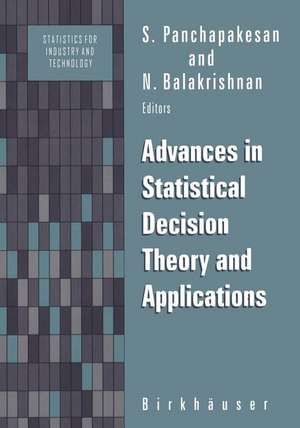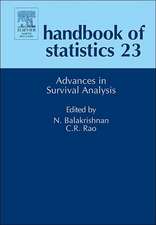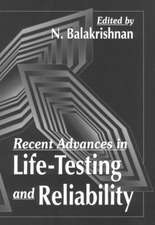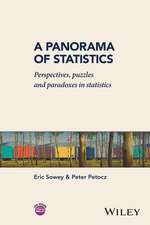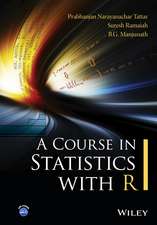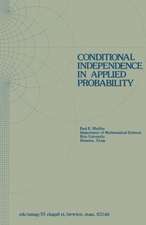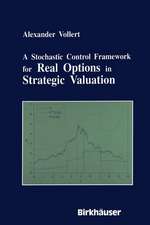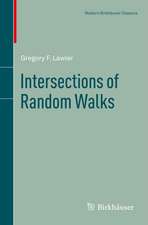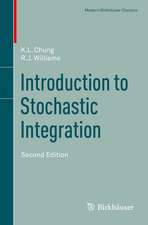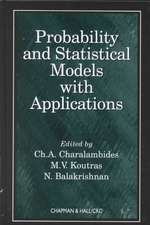Advances in Statistical Decision Theory and Applications: Statistics for Industry and Technology
Editat de S. Panchapakesan, N. Balakrishnanen Limba Engleză Paperback – 15 sep 2011
Din seria Statistics for Industry and Technology
- 18%
 Preț: 965.02 lei
Preț: 965.02 lei -
 Preț: 407.01 lei
Preț: 407.01 lei - 18%
 Preț: 958.38 lei
Preț: 958.38 lei -
 Preț: 404.89 lei
Preț: 404.89 lei - 18%
 Preț: 1240.30 lei
Preț: 1240.30 lei - 18%
 Preț: 1234.00 lei
Preț: 1234.00 lei - 15%
 Preț: 651.34 lei
Preț: 651.34 lei - 5%
 Preț: 1124.07 lei
Preț: 1124.07 lei - 18%
 Preț: 973.38 lei
Preț: 973.38 lei - 18%
 Preț: 1017.11 lei
Preț: 1017.11 lei - 18%
 Preț: 965.20 lei
Preț: 965.20 lei - 15%
 Preț: 651.19 lei
Preț: 651.19 lei - 15%
 Preț: 655.60 lei
Preț: 655.60 lei -
 Preț: 421.43 lei
Preț: 421.43 lei - 18%
 Preț: 1244.89 lei
Preț: 1244.89 lei -
 Preț: 400.65 lei
Preț: 400.65 lei -
 Preț: 397.38 lei
Preț: 397.38 lei - 18%
 Preț: 1109.44 lei
Preț: 1109.44 lei -
 Preț: 409.89 lei
Preț: 409.89 lei - 15%
 Preț: 640.55 lei
Preț: 640.55 lei -
 Preț: 400.26 lei
Preț: 400.26 lei - 15%
 Preț: 665.08 lei
Preț: 665.08 lei - 18%
 Preț: 784.59 lei
Preț: 784.59 lei - 15%
 Preț: 661.48 lei
Preț: 661.48 lei - 18%
 Preț: 962.98 lei
Preț: 962.98 lei - 18%
 Preț: 1132.33 lei
Preț: 1132.33 lei - 18%
 Preț: 1124.30 lei
Preț: 1124.30 lei - 18%
 Preț: 966.59 lei
Preț: 966.59 lei
Preț: 407.19 lei
Nou
Puncte Express: 611
Preț estimativ în valută:
77.92€ • 84.62$ • 65.46£
77.92€ • 84.62$ • 65.46£
Carte tipărită la comandă
Livrare economică 22 aprilie-06 mai
Preluare comenzi: 021 569.72.76
Specificații
ISBN-13: 9781461274957
ISBN-10: 1461274958
Pagini: 504
Ilustrații: 498 p.
Dimensiuni: 178 x 254 x 26 mm
Greutate: 0.87 kg
Ediția:Softcover reprint of the original 1st ed. 1997
Editura: Birkhäuser Boston
Colecția Birkhäuser
Seria Statistics for Industry and Technology
Locul publicării:Boston, MA, United States
ISBN-10: 1461274958
Pagini: 504
Ilustrații: 498 p.
Dimensiuni: 178 x 254 x 26 mm
Greutate: 0.87 kg
Ediția:Softcover reprint of the original 1st ed. 1997
Editura: Birkhäuser Boston
Colecția Birkhäuser
Seria Statistics for Industry and Technology
Locul publicării:Boston, MA, United States
Public țintă
ResearchCuprins
I: Bayesian Inference.- 1 Bayes for Beginners? Some Pedagogical Questions.- 2 Normal Means Revisited.- 3 Bayes m-Truncated Sampling Allocations for Selecting the Best Bernoulli Population.- 4 On Hierarchical Bayesian Estimation and Selection for Multivariate Hypergeometric Distributions.- 5 Convergence Rates of Empirical Bayes Estimation and Selection for Exponential Populations With Location Parameters.- 6 Empirical Bayes Rules for Selecting the Best Uniform Populations.- II: Decision Theory.- 7 Adaptive Multiple Decision Procedures for Exponential Families.- 8 Non-Informative Priors Via Sieves and Packing Numbers.- III: Point And Interval Estimation—Classical Approach.- 9 From Neyman’s Frequentism to the Frequency Validity in the Conditional Inference.- 10 Asymptotic Theory for the Simex Estimator in Measurement Error Models.- 11 A Change Point Problem for Some Conditional Functionals.- 12 On Bias Reduction Methods in Nonparametric Regression Estimation.- 13 Multiple Comparisons With the Mean.- IV: Tests Of Hypotheses.- 14 Properties of Unified Bayesian-Frequentist Tests.- 15 Likelihood Ratio Tests and Intersection-Union Tests.- 16 The Large Deviation Principle for Common Statistical Tests Against a Contaminated Normal.- 17 Multiple Decision Procedures for Testing Homogeneity of Normal Means With Unequal Unknown Variances.- V: Ranking and Selection.- 18 A Sequential Multinomial Selection Procedure With Elimination.- 19 An Integrated Formulation for Selecting the Best From Several Normal Populations in Terms of the Absolute Values of Their Means: Common Known Variance Case.- 20 Applications of Two Majorization Inequalities to Ranking and Selection Problems.- VI: Distributions AND Applications.- 21 Correlation Analysis of Ordered Observations From aBlock-Equicorrelated Multivariate Normal Distribution.- 22 On Distributions With Periodic Failure Rate and Related Inference Problems.- 23 Venn Diagrams, Coupon Collections, Bingo Games and Dirichlet Distributions.- VII: Industrial Applications.- 24 Control Charts for Autocorrelated Process Data.- 25 Reconstructive Estimation in a Parametric Random Censorship Model With Incomplete Data.- 26 A Review of the Gupta-Sobel Subset Selection Rule for Binomial Populations With Industrial Applications.- 27 The Use of Subset Selection in Combined-Array Experiments to Determine Optimal Product or Process Designs.- 28 Large-Sample Approximations to Best Linear Unbiased Estimation and Best Linear Unbiased Prediction Based on Progressively Censored Samples and Some Applications.
